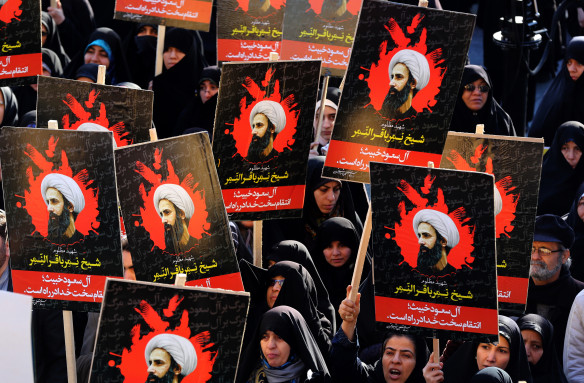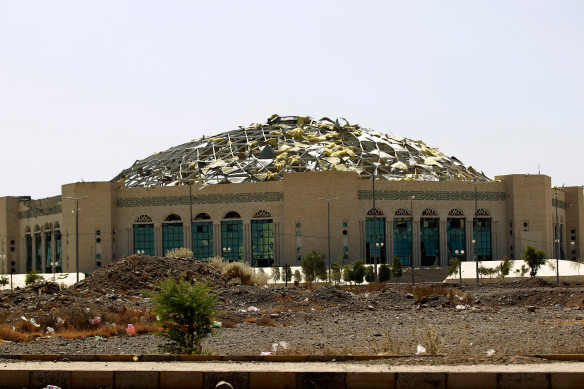Clash of Theocracies
By Mahir Ali | News & Politics | Published 10 years ago
If Riyadh’s execution last month of Shia cleric Sheikh Nimr al-Nimr was intended to provoke from Tehran the kind of response that would jeopardise its nuclear deal with the United States and other western powers, it was a signal failure.
The vehement reaction from Iran’s hierarchy was broadly predictable. The Twitter account of the supreme leader, Ayatollah Ali Khamenei, even put up a cartoon equating the Saudi regime with Islamic State. Beyond that, however, he merely predicted the visitation of divine wrath on Riyadh. There was no precipitate action, apart from a mob attack on the Saudi embassy.
Hardline elements in the regime may well have encouraged this display of rowdiness, but it was roundly condemned by the voices that matter, and no diplomats were harmed in the poorly-scripted drama. The Saudis promptly severed diplomatic relations and persuaded a number of their acolytes in the Gulf region and Africa to follow suit.
More broadly, however, the violence in Tehran contributed only peripherally to blurring the image of the state-ordained violence in Riyadh. Nimr was ostensibly a non-violent critic of the regime, charged with disobedience to the monarch. Three of the 46 others executed on January 2 were, likewise, Shia activists. The remainder were supposedly terrorists associated with Al Qaeda and the like, some of whom had been incarcerated for more than a decade.
Including Nimr and his fellow Shias among those deemed worthy of beheading is also seen as a sop to the Wahhabi clergy on which the al-Saud regime relies for sustenance, and which may have been more perturbed by the exclusive execution of its brethren-in-faith. It was decidedly a deliberately provocative signal to Iran as well.
Saudi hopes are bound to have soared once more when, not long afterwards, a couple of American vessels strayed into Iranian waters and their crews were taken into captivity. And the civilised outcome of that potential confrontation must have come as a blow. US Secretary of State John Kerry got on the phone to his Iranian counterpart, Javad Zarif, and the American crews were at liberty within 24 hours, preceded by an apology and followed by an expression of gratitude.
A few days later, sanctions against Iran were lifted — although new ones were promptly imposed in response to its advances in ballistic missile technology. The latter are more of a token gesture, though, and Iran potentially has much to gain from the unfreezing of funds, as well as the influx of fresh investment, spearheaded by Europe. Expectations have inevitably been raised within Iran on the prospects of emerging from an ongoing recession, notwithstanding the sharply diminished price of oil.
By some accounts, the oil price is yet to hit rock bottom: it could descend to $10 a barrel. The Saudis have been complicit in the decline, mainly by refusing to lower their output, partly in order to hurt Russia and Venezuela — and thereby to please Washington and possibly Tel Aviv. They are also suffering the consequences, though, and as a response the deputy crown prince, Mohammed bin Salman, is contemplating economic “reforms” on the Thatcherite model that would entail sharp drops in subsidies, higher sales taxes and possibly the partial floating of Aramco, effectively the economic soul of the Saudi state.
It’s a high-risk strategy, given that the House of Saud has hitherto relied on buying the loyalty of the Saudi populace. The outbreak of the Arab Spring five years ago, after all, prompted a monumental display of state generosity. It seems to have worked, but the consequences of reversing that strategy are unpredictable. The public mood could turn quite sharply were state largesse to be curtailed or cut off in Saudi Arabia and the neighbouring Gulf states, where Allah and Mammon have always competed for popular adoration.

Part of the problem is what Saudi Arabia has spent on its war of attrition in Yemen, again under the auspices of Mohammed bin Salman, the king’s favourite son, who also happens to be the defence minister. Operation Decisive Storm was launched with the intention of demonstrating to Iran in short order that its proxy wars were unwinnable. There are two problems with that thesis. First, the extent to which the Iranians were involved at the outset with the Houthi militias that sought to establish their ascendancy in an anarchic Yemen is questionable, as even Barack Obama has admitted. Secondly, the storm has thus far been decidedly indecisive, and there are no indications of a victory at hand.
This is not the first time Yemen has been the battleground in a proxy war. The last time was some 50 years ago, when the Saudis were seeking to limit the pan-Arabist influence of Egypt’s Gamal Abdel Nasser. Neither side completely triumphed back then, but Yemen was divided into two — with the southern part, today under the thumb of the Saudis’ Emirati collaborators, emerging as the first communist state in the Arab world.
The Iranians have consistently denied involvement in Yemen, while berating the Saudis for ravaging a fellow Arab country. In Syria, on the other hand, the rivalries are much clearer. The Iranians have sought for the past five years to bolster the Alawite-led regime of Bashar al-Assad, while the Saudis have openly striven to undermine it. The latter were mightily upset when the regimes of Zine el-Abidine Ben Ali and Hosni Mubarak in Tunisia and Egypt respectively succumbed in the face of popular revolts. The uprising in Libya, on the other hand, was viewed as a divinely ordained opportunity to get rid of Muammar Gaddafi of Libya, and Syria was seen in pretty much the same light.
The Saudi perception of Damascus has not evolved, though, in the light of the devastating consequences of regime change in Tripoli. The likelihood of a negotiated settlement in Syria, meanwhile, has been considerably set back by the diplomatic impasse between Saudi Arabia and Iran. The Russian intervention, for whatever it is worth, has meanwhile complicated matters for the Saudis and the Turks, both of whom stand accused of aiding Islamist forces whose ascendancy would likely transcend Assad’s grotesque excesses.
For the moment, though, it’s possible to see Mohammed bin Salman’s ascendancy as the biggest problem. The 30-year-old defence minister’s relative youth should militate in his favour in a nation where 70 per cent of the population is under that age, and he has been involved in royal politics since the age of 12. His father was governor of Riyadh for decades, and Mohammed is used to standing in for his father, now 80, who was reportedly ailing even before he ascended the throne last year. Prince Mohammed bin Nayef, the crown prince and interior minister, completes the triumvirate.
Given the younger Mohammed’s ambitions, however, many observers reckon it is unlikely that his elder cousin will be king when the baton passes to the next generation of the Saudi founding father’s progeny. There have been reports of ructions within the royal family, with other branches resenting the charted course of succession. The biggest danger, though, arguably lies in the younger Mohammed instigating an action that spirals out of control. For the moment, a direct confrontation between Saudi Arabia and Iran does not appear to be on the cards. But can anyone be entirely sure of that? The consequences, both within the Middle East and far beyond, are too horrible to contemplate. If something does go wrong, though, this appears to be the likeliest year.
It is not entirely inconceivable, though, that the crucial folly could flow from malfeasance in Tehran. Notwithstanding the moderate facade of the present regime, quite possibly projected in good faith by President Hassan Rouhani and his foreign minister, there are hardliners waiting in the wings who disdain the nuclear deal as well as any decorum in dealings with Riyadh.
When Tehran objected in the strongest terms to Sheikh Nimr’s execution, many called out its hypocrisy, given that Iran is no stranger to executions — in fact, despite Saudi Arabia’s best efforts, it manages to score the highest number per capita. At least some of the victims face the gallows on confessional grounds. Iran’s version of democracy, meanwhile, remains highly controlled by the clerical hierarchy, which vets all candidates for parliamentary posts.
Before the Iranian revolution of 1979, Riyadh and Tehran were on relatively good terms, with the Saudis perfectly willing to cede to the Shah the role of the western-ordained policeman of the Gulf. They predictably backed Saddam Hussein’s aggression against Iraq, and then the US assault against the Iraqi dictator 25 years ago, and again in 2003. Saudi Arabia, which now sees eye-to-eye with Israel on a broad range of Middle Eastern issues, and Iran have plenty of cause to be wary of one another. The proxy conflicts between the two, notably in Yemen and Syria, are bad enough. A direct conflict between the rival theocracies would be more devastating than anything the Middle East has witnessed in a century. Unfortunately, it cannot be entirely ruled out this year.
This article was originally published in Newsline’s February 2016 issue.
Mahir Ali is an Australia-based journalist. He writes regularly for several Pakistani publications, including Newsline.



